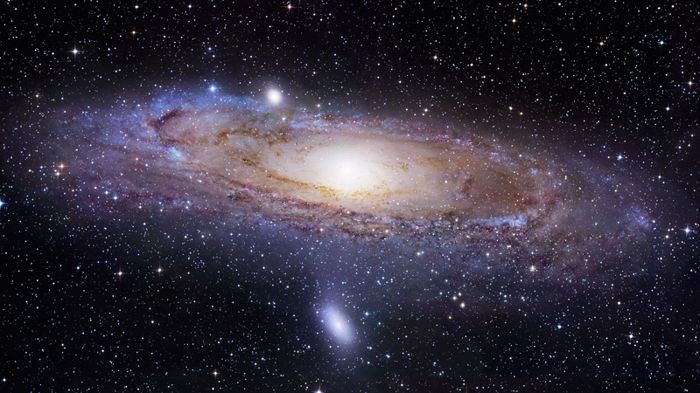The Andromeda Galaxy, also known as the M31 galaxy, predicts that the Andromeda Galaxy will collide with the Milky Way in the next 4.5 billion years based on Gaia satellite observations. This spiral galaxy is the largest neighboring galaxy in the Milky Way.
The figure shows the trajectories of the future three galaxy. The blue lines are the trajectories of the Milky Way; the red lines are the trajectories of the Andromeda galaxy; the green lines are the trajectories of the galaxy. According to observations from the European Gaia satellite, the Milky Way and the Andromeda Galaxy will collide in 4.5 billion years. Sina Technology News Beijing time on February 11th news, according to the US space website, at present, a new study shows that our Galaxy exists in the current form for a longer time than some astronomers predicted.
According to the latest research, the Milky Way and the Andromeda spiral galaxy will collide in the next 4.5 billion years. This is based on data from the European Gaia satellite observations, but some well-known experts have predicted that the two galaxy will collide in about 3.9 billion years. Timo Prusti, a scientist in the Asia-Pacific spacecraft project, said in a statement that the discovery is critical to our understanding of how galaxy evolve and interact. The Gaia satellite was launched in December 2013 and is able to help researchers create the best galaxy 3D map ever. The satellite has been accurately monitoring the position and motion of a large number of stars and other cosmic objects. The team’s goal is to track and monitor more than one billion stars before the Gaia satellites end their service.
Most of the stars observed by the Gaia satellite are located in the Milky Way, but there are also some stars in nearby galaxy. In this latest study, the researchers tracked and analyzed some of the stars of the Milky Way, Andromeda and Trigonean galaxy, which are within 2.5 to 3 million light years from the Milky Way, and they may interact with each other. Roeland van der Marel, the lead author of the study, and the Baltimore Space Telescope Science Institute in the United States said that we need to explore the 3D movements of these galaxy to reveal how they grow and evolve. And how they create and influence their characteristics and behavior. Marel emphasized that we used the second set of high-quality data collected by Gaia satellites (data released in April 2018) to explore the trajectories of these galaxy.
This research effort enabled the research team to determine the rate of rotation of the Andromeda Galaxy and the Trigonometric Galaxy, which has never been done before. Using Gaia satellite observations and archival information analysis, the team mapped out how the Andromeda and Trigonometry moved in space before, and what trajectories might occur in the next few billion years.
The team’s computational model provided a time for the Andromeda Galaxy-Galaxy to collide, and the results showed later than previously predicted. At the same time, they suggest that the two galaxy may be side collisions rather than frontal collisions. Because the distance between the stars is very large, the probability of our solar system being collided is very low, but for any creature on the planet after 4.5 billion years, this galaxy collision will make the night sky brighter.
“The Gaia satellite was designed primarily to map stars within the Milky Way, but this latest study shows that the observed performance of this satellite far exceeds expectations, and it can structure the galaxy outside the Milky Way,” And dynamics provide unique insights. The longer the Gaia satellites observe the tiny movements of these galaxy, the more accurate our measurements are.”
The latest research report is currently published in the February issue of the Journal of Astrophysics. It is worth mentioning that the Andromeda Galaxy is not the next collision galaxy in the Milky Way. The latest study shows that the Big Magellanic Cloud will collide with the Milky Way after about 2.5 billion years.




